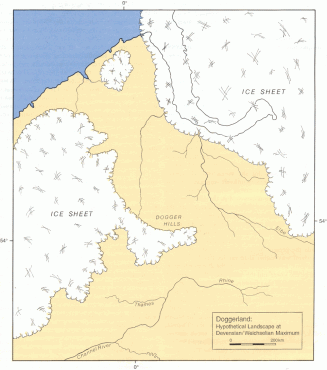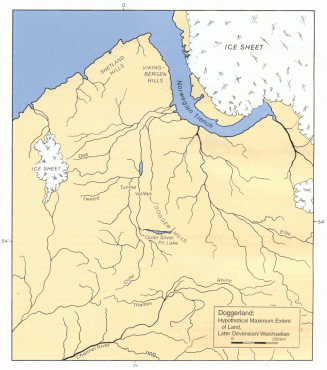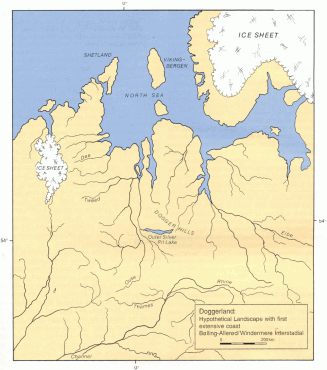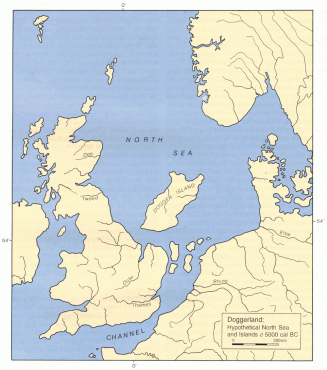In the Prehistoric Society’s 1998 annual journal, the archaeologist Bryony Coles contributed a survey of the land that had once existed under the southern North Sea.* She named this place “Doggerland” (after the Dogger sandbank) and pointed to evidence of a distinct landscape and a unique people who had left behind tools different from those found in the adjoining countries.
Around 5500BC this land was completely submerged and thus lost to the sea. But on the coasts around that sea, centuries of land reclamation have taken place. Swathes of Holland, East Anglia, Frisia, Flanders and Jutland have been formed by digging dykes and dredging the seabed. As is evident in Happisburgh in Norfolk or on the island of Sylt, the sea is all too willing to get these places back. Nation states have to build coastal defences to keep hold of these lands. If they didn’t, they would be subsumed back into the sea.
You could argue that these places should, by right, belong to the North Sea – and, if so, to Doggerland – and not to the Netherlands, to the United Kingdom, to Belgium, to Germany or to Denmark. Perhaps Doggerland still exists, and perhaps it has a right to its own nationhood.
This project is an attempt to remap Europe and claim back the lost territories of the North Sea.
* Coles, BJ, 1998, “Doggerland: A speculative survey”, Proceedings of Prehistoric Society vol 64.
****
The following images have been scanned from Coles’s paper and are copyright BJ Coles and SE Rouillard.






I have read the interresting article about Doggerland. I am a danish amateur-archaeologist, and I new that the North Sea had earlier been dry land, but I have allways thourght of it as kind of a land-bridge, untlill I early thi, wheres summer saw a program on National Geograpphic television called “The Atlantis og the North”, where they told about all
the interresting objects that has been found on the shores
around the North Sea both in England, Holland and France,
and I look forward to hear more about this and I will consult
your website freequently.
how intresting to be able to create or bring back a lost country. how far under the water is the dogger island and could it really be done to re surface this island ? steve laird
Through Oral History we knew of this sea (Dogger Banks) and land, through knowing the mainland slipped away from other isles. Our Dogger ancestors date back to 1607, Obbe Saak Dogger. Until this time children took the first name of their fathers ie: son of Obbe Saak would be Saak Obbe. At this time (1600’s) the fishermen took the name Dogger as they fished in the sea for DogFish (cod). We search for what we teasingly call our *Holy Grail* ; a silver goblet gifted to a Dogger who was Captain of a whaler and caught 13 whales in one season. We have seen a photo of this Goblet and the name inscribed.. WE shudder now to even think of a whale being caught for oil or “sport”
Doggers in Canada are rare, there may be no boy children left to carry on the name.. Not so in Australia where there appear to be many .
I continue using my maiden name to sign my photography and paintings.. Sandra Dogger Klassen
I have never heard of Doggerland until recently my wife and i had our genetic profile done by a company called 23andme.. That profile includes diseases,carrier status,traits,and low and behold ancestry.. My Y chromosome contains with a high degree of certainty completely Doggerland DNA. The Y chromosome does not share DNA with the X (female) chromosome. In fact it is and exact copy of my fathers and his fathers all the way back to when the genetic mutation first happened, Doggerland. It is fascinating that my ancestral home is now under water. I want my land back.
Frank Boyle Lexington,Kentucky,USA
I take it that you’re an I1 Haplogroup, also?
Dear Frank, I was fascinated by your post. I work at the University of East London and with some colleagues am working on a performance based on Doggerland and wondered if there was any way of including some of your information in some way. Would it be possible for us to correspond by email?
Well, I never! I came across this website (or is it a blog?) almost by accident during research into the coble – an inshore fishing boat prevalent along the east coast of England. I knew, very sketchily, about the land bridge between the UK and the continent, but the historical sources that this site has thrown up are amazing and have certainly opened up my eyes! The next time I gaze out across the North Sea when fishing off a Northumbrian beach, I’ll be thinking of you all. Well done and more power to your elbow!
Just got my 23 and Me DNA results and my mtDNA traces back to Northern Europe and Doggerland, I never heard of it until now.
My Mtdna also comes from Doggerland, how so? what is it that tells them this
under our domain http://www.state-union.us a report re. doggerbank
steven baxter wrote three alternate histories novels on this doggerland well researched and compelling try them
I find it pretty hard to believe any oral tradition would date back to 5000 BC. Certainly there are cultural traditions of fisherman working the Dogger bank that gave it’s name to Doggerland. Those, however, would date back only a few hundred years and would not preserve any memory of this paleolithic island culture. As to DNA, certainly one might establish an mtDNA link to Northern Europe, but what kinds of remains would they be comparing them to in order to establish a connection with Doggerland?
What a coincidence! Jim was the name of the father of the Wilson I knew. Yet it’s been 37 years since we last met. No of course there is no such collective memory . My red haired Aunt was her generations family oral historian . She recited this to myself and siblings in the late 1950s . Ancestral accounts on Texel Island off Holland link us back to 1600s including occupations awards to one Simon Dogger for his catch one year of 13 whales. The silver Goblet remains our dogger family a “holy grail”. We have seen photos of it, know of this history through Texel Island . Now in 2015 there are humans finding DNA connections with the remains of the Neanderthal found on the Doggerland floor. More recently has been a discovery of a forest which appears as a mound, further proof of a tsunami . This historical search gets curiouser and curiouser . Cheers Sandra
[…] this same period, Doggerland in what is now the North Sea, was also being flooded. The last bit of land there, what is now […]
23andme also mentions Doggerland when talking about my Y chromosome. My particular mutation of the Y chromosome appears in people who originate on the coast of the North Sea both in Britain and mainland Europe. The average rate of mutation would have it arising about the same time as Doggerland was last dry land. So far as I know no actual human remains from Doggerland have been sequenced to confirm this theory, but the available information seems to point in that direction.
I’m from Doggerland too apparently – on 23andme I discovered I have the I2b1 haplogroup. Now I need to go and find my brothers in Vasterbotten in North Sweden to assemble an army to reclaim our lost land. Or at least build a house on stilts, compose a new national anthem and probably drink some beer.
To all my brethren, remember Doggerland!
[…] The Prehistoric Society / Via log.doggerland.net […]
[…] The Prehistoric Society / Via log.doggerland.net […]
Yes a new land for a new Super City & Capital for Europe, owned by all of us, and not sovereignty problems.
[…] Estates and Aggregate Industries that have mapped the now submerged palaeo-landscapes known as Doggerland. Scientists have coupled geophysical survey techniques developed by the oil industry with 3D […]